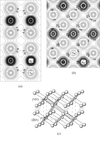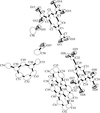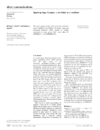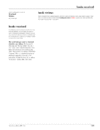issue contents
October 2001 issue

Cover illustration: The structure of Pu31Pt20 [D. T. Cromer & A. C. Larson (1977). Acta Cryst. B33, 2620-2627] viewed nearly perpendicular to a Pu, Pt disc (10 Å thick and 50 Å in diameter) down [111]. Details of the structure were taken from the intermetallics crystal structure database CRYSTMET® using the Materials ToolKit graphics software from Toth Information Systems, Inc.
lead articles
The present knowledge of the crystallographic and structural properties of phosphate tungsten bronzes is given. The building of this family of compounds, focused on the tilt phenomenon of the octahedra involving a great variety of structures with different symmetries as well as the existence of numerous twins, is described.
research papers
The chemical bonds and the valence electron density of the average structure of incommensurate AuTe2 are analysed in the framework of density functional theory.
Download citation


Download citation


The topological analysis of the experimental electron density, determined by fitting a multipole model to high-resolution X-ray diffraction data collected at 120 K, confirms the presence of a `closed-shell' Co—Co bond in the title compound.
The occurrence of a pentagonal cluster in several approximants to decagonal quasicrystals is discussed. The cluster is the main constituent of the decagonal approximant structure types Al3Mn, Al60Mn11Ni4 and Ga137Mn123.
An extension of the charge distribution method is presented, which exploits the iterative calculation of the effective coordination number, a specific contraction parameter for the hydrogen bonds and iterative scale factors for hetero-ligand polyhedra. Iteration allows the analysis of rather distorted coordination polyhedra through their charge distribution. Applications to oxides of pentacoordinated cations are shown. A computer program is available.
Download citation


Download citation


X-ray powder diffraction with synchrotron radiation is used to study the pressure dependences of the crystal structures of Nb3Te4 and InxNb3Te4 (x = 0.54) between 0 and 40 GPa.
Download citation


Download citation


The crystal structure of pentamethylcyclopentadienylsodium (NaCp*) has been determined from high-resolution X-ray powder diffraction. The crystal structure consists of polymeric multidecker chains along the crystallographic a axis. The pentamethylcyclopentadienyl anions are coplanar with each other and show twofold rotational disorder.
Download citation


Download citation


The strongly ruffled, odd-alternant radical C13Cl9 stacks along crystallographic threefold axes, but the intrastack spacing is too large for the material to be a good conductor. The spacing is determined by interstack interactions, which are also responsible for the structural modulations.
Download citation


Download citation


A detailed comparison is made of the structures of 2(benzene-1,3,5-tricarboxylic acid)·1.5(pyrene)·2(methanol) (new determination) and of 2(benzene-1,3,5-tricarboxylic acid)·pyrene·2(ethanol) (data from the literature).
Download citation


Download citation


The third polymorph of maleic hydrazine (MH3) is monoclinic, space group P21/n, with the same pattern of hydrogen-bonded lactam–lactim tautomers as the two previously studied polymorphs, the triclinic MH1 and the monoclinic MH2. The interplay between the distortions of the hydrogen-bonded aggregates, their arrangements and symmetries of the polymorphs is analysed.
Download citation


Download citation


The crystal structures of two 2-substituted cyclohexanone oximes and of the parent cyclohexanone oxime are reported and discussed in terms of three different types of hydrogen-bond patterns along with the πC=N/σ*C—X orbital interaction which stabilizes the axial conformation of the 2-substituted oximes.
Download citation


Download citation


Molecular structural parameters of two potential drugs against Trypanosoma cruzi epimastigotes have been studied using a combination of a stereoselective route, spectroscopic characterization and single-crystal X-ray analysis.
short communications
The space group for the entry under the reference codes FEBMUU and FEBMUU01 in the Cambridge Structural Database should be further corrected to space group C2/c rather than P1 (FEBMUU) or C2 (FEBMUU01).
books received
Free 



 journal menu
journal menu





























